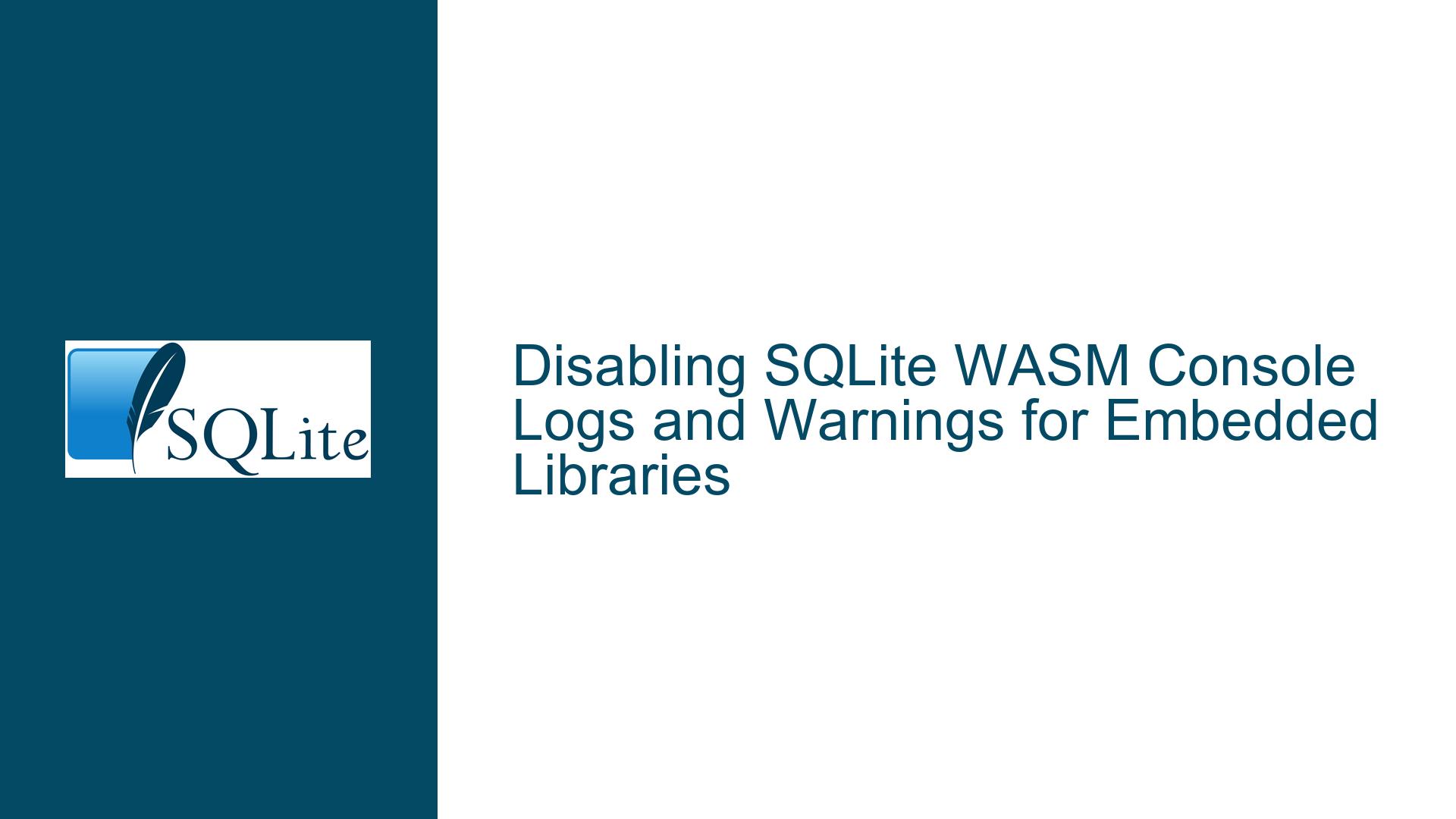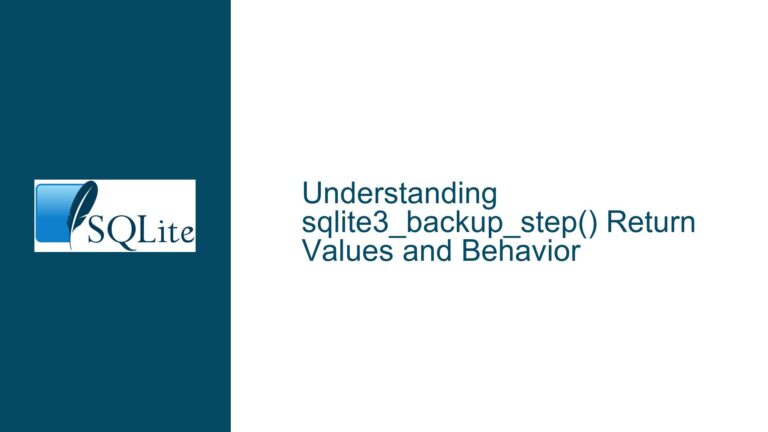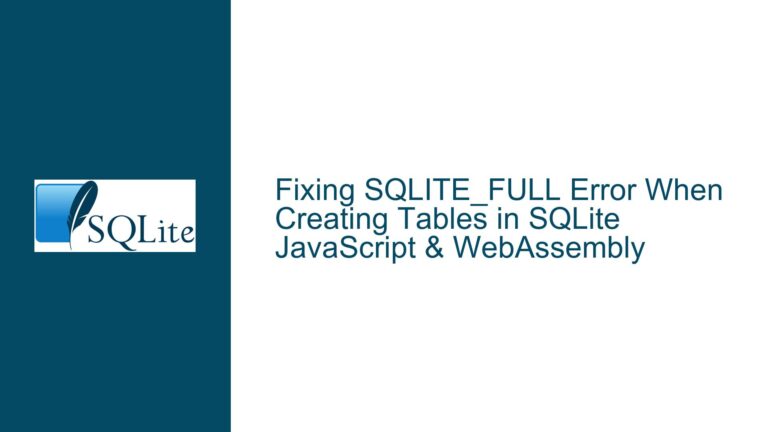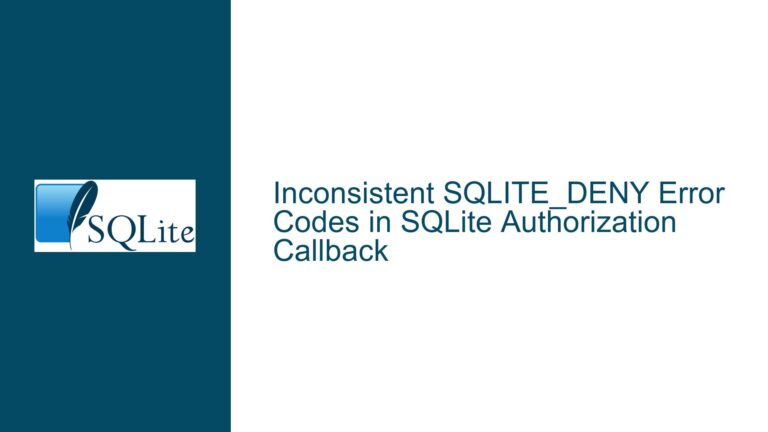Disabling SQLite WASM Console Logs and Warnings for Embedded Libraries
Understanding the Need to Suppress SQLite WASM Console Logs and Warnings
When embedding SQLite WASM (WebAssembly) into a library or application, developers often encounter console logs and warnings that are intended for debugging or informational purposes. These messages, while useful during development, can be disruptive or confusing for end-users who are not involved in the debugging process. The core issue revolves around the desire to suppress or customize these console outputs, particularly in environments where SQLite WASM is embedded within another library or framework.
The discussion highlights two specific types of console outputs that developers wish to control: the "Installing sqlite3 bits" log and the "Ignoring inability to install OPFS sqlite3_vfs" warning. The former is a general log message that appears during the initialization of SQLite WASM, while the latter is a warning that occurs when the Origin Private File System (OPFS) VFS (Virtual File System) cannot be installed due to runtime constraints, such as the absence of Atomics.wait() in the main thread.
The challenge lies in balancing the need for informative debugging messages for developers with the desire for a clean, user-friendly experience for end-users. This balance is particularly important when SQLite WASM is embedded in libraries that are distributed to third-party developers or end-users who may not have the technical expertise to interpret these messages.
Exploring the Causes of Unwanted Console Logs and Warnings
The primary cause of unwanted console logs and warnings in SQLite WASM is the library’s default behavior of emitting diagnostic messages to the console. These messages are designed to assist developers in understanding the internal state of the library, particularly during initialization and when encountering runtime errors or limitations. However, this behavior becomes problematic when SQLite WASM is embedded in another library or application, as the console outputs may not be relevant or useful to the end-user.
The "Installing sqlite3 bits" log is emitted during the initialization of SQLite WASM, specifically when the library is setting up its internal structures and preparing to interact with the host environment. This log is intended to inform developers that the library is being initialized, but it can be perceived as noise in an embedded context.
The "Ignoring inability to install OPFS sqlite3_vfs" warning is more specific and occurs when the library attempts to install the OPFS VFS but encounters a runtime limitation, such as the absence of Atomics.wait() in the main thread. This warning is intended to alert developers to the fact that the OPFS VFS cannot be used in the current environment, but it can be confusing or alarming to end-users who are not familiar with the technical details of SQLite WASM or the OPFS VFS.
Another contributing factor is the lack of a built-in mechanism for suppressing or customizing these console outputs. While SQLite WASM provides a global configuration object (sqlite3ApiConfig) that can be used to influence the library’s behavior, this feature is not well-documented or widely known. As a result, developers may not be aware of the options available to them for controlling console outputs, leading to frustration and the perception that the library is overly verbose.
Comprehensive Solutions for Suppressing and Customizing Console Outputs
To address the issue of unwanted console logs and warnings in SQLite WASM, several solutions and best practices can be employed. These solutions range from simple configuration changes to more advanced techniques for customizing the library’s behavior.
1. Using the sqlite3ApiConfig Object to Suppress Console Outputs
The most straightforward solution is to use the sqlite3ApiConfig object to suppress console outputs during the initialization of SQLite WASM. This object allows developers to override the default console methods (debug, log, warn, and error) with custom implementations, effectively silencing any messages emitted by the library.
To implement this solution, developers can define the sqlite3ApiConfig object before importing the SQLite WASM library. For example:
self.sqlite3ApiConfig = {
debug: () => {},
log: () => {},
warn: () => {},
error: () => {}
};
import sqlite3 from 'sqlite3-wasm';
const sqlite3 = await sqlite3ApiInit();
In this example, the debug, log, warn, and error methods are overridden with no-op functions, effectively silencing all console outputs from the library. After the library has been initialized, the sqlite3ApiConfig object can be deleted to clean up the global namespace.
2. Customizing Console Outputs for Specific Use Cases
While suppressing all console outputs may be sufficient for some use cases, other scenarios may require more fine-grained control over the library’s behavior. For example, developers may wish to suppress certain types of messages while allowing others to be displayed, or they may want to redirect console outputs to a custom logging system.
To achieve this level of customization, developers can implement their own console methods within the sqlite3ApiConfig object. For example:
self.sqlite3ApiConfig = {
debug: (message) => {
if (shouldLogDebug(message)) {
console.debug(message);
}
},
log: (message) => {
if (shouldLogInfo(message)) {
console.log(message);
}
},
warn: (message) => {
if (shouldLogWarning(message)) {
console.warn(message);
}
},
error: (message) => {
if (shouldLogError(message)) {
console.error(message);
}
}
};
import sqlite3 from 'sqlite3-wasm';
const sqlite3 = await sqlite3ApiInit();
In this example, the shouldLogDebug, shouldLogInfo, shouldLogWarning, and shouldLogError functions are used to determine whether a given message should be logged. This approach allows developers to implement custom filtering logic based on the content or context of the message, providing greater control over the library’s console outputs.
3. Throwing Explicit Errors for Unsupported Operations
Another approach to handling unwanted console outputs is to replace warnings with explicit errors when unsupported operations are attempted. This approach is particularly useful for scenarios where the library is being used in an environment that does not support certain features, such as the OPFS VFS.
For example, instead of emitting a warning when the OPFS VFS cannot be installed, the library could throw an error with a descriptive message. This approach makes it clear to developers that the operation is not supported in the current environment, reducing the likelihood of confusion or misinterpretation.
To implement this solution, developers can modify the library’s initialization logic to check for the availability of required features before attempting to install the OPFS VFS. If the required features are not available, an error can be thrown with a descriptive message. For example:
if (!isOpfsSupported()) {
throw new Error('The OPFS VFS cannot be installed because the required features are not available in the current environment.');
}
const db = new sqlite3.oo1.OpfsDb('/evolu/evolu1.db', 'c');
In this example, the isOpfsSupported function is used to check whether the required features (such as Atomics.wait()) are available in the current environment. If the features are not available, an error is thrown with a descriptive message, making it clear to developers that the operation is not supported.
4. Providing a URL Parameter for Enabling Debug Outputs
For scenarios where developers need to enable debug outputs temporarily, a URL parameter can be used to control the verbosity of the library’s console outputs. This approach allows developers to enable debug outputs when needed, without requiring changes to the code or configuration.
To implement this solution, developers can modify the library’s initialization logic to check for a URL parameter (such as enable_sqlite_warnings) and adjust the verbosity of the console outputs accordingly. For example:
const urlParams = new URLSearchParams(window.location.search);
const enableWarnings = urlParams.has('enable_sqlite_warnings');
self.sqlite3ApiConfig = {
debug: enableWarnings ? console.debug : () => {},
log: enableWarnings ? console.log : () => {},
warn: enableWarnings ? console.warn : () => {},
error: enableWarnings ? console.error : () => {}
};
import sqlite3 from 'sqlite3-wasm';
const sqlite3 = await sqlite3ApiInit();
In this example, the enable_sqlite_warnings URL parameter is used to determine whether debug outputs should be enabled. If the parameter is present, the default console methods are used; otherwise, no-op functions are used to suppress the outputs.
5. Documenting Best Practices for Embedding SQLite WASM
Finally, to help developers avoid common pitfalls and ensure a smooth integration of SQLite WASM into their libraries and applications, it is important to document best practices for embedding the library. This documentation should cover topics such as:
- How to use the
sqlite3ApiConfigobject to suppress or customize console outputs. - How to check for the availability of required features before attempting to use them.
- How to handle errors and warnings in a way that is consistent with the rest of the application.
- How to use URL parameters to enable debug outputs temporarily.
By providing clear and comprehensive documentation, developers can more easily understand the options available to them and make informed decisions about how to integrate SQLite WASM into their projects.
Conclusion
Suppressing and customizing console logs and warnings in SQLite WASM is a critical aspect of embedding the library into other applications and libraries. By using the sqlite3ApiConfig object, developers can control the library’s console outputs, ensuring a clean and user-friendly experience for end-users. Additionally, by implementing explicit error handling and providing URL parameters for enabling debug outputs, developers can strike a balance between informative debugging messages and a polished user experience. Finally, documenting best practices for embedding SQLite WASM can help developers avoid common pitfalls and ensure a smooth integration process.






